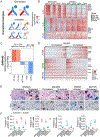Mutant IDH inhibitors induce lineage differentiation in IDH-mutant oligodendroglioma
- PMID: 38579724
- PMCID: PMC11096020
- DOI: 10.1016/j.ccell.2024.03.008
Mutant IDH inhibitors induce lineage differentiation in IDH-mutant oligodendroglioma
Abstract
A subset of patients with IDH-mutant glioma respond to inhibitors of mutant IDH (IDHi), yet the molecular underpinnings of such responses are not understood. Here, we profiled by single-cell or single-nucleus RNA-sequencing three IDH-mutant oligodendrogliomas from patients who derived clinical benefit from IDHi. Importantly, the tissues were sampled on-drug, four weeks from treatment initiation. We further integrate our findings with analysis of single-cell and bulk transcriptomes from independent cohorts and experimental models. We find that IDHi treatment induces a robust differentiation toward the astrocytic lineage, accompanied by a depletion of stem-like cells and a reduction of cell proliferation. Furthermore, mutations in NOTCH1 are associated with decreased astrocytic differentiation and may limit the response to IDHi. Our study highlights the differentiating potential of IDHi on the cellular hierarchies that drive oligodendrogliomas and suggests a genetic modifier that may improve patient stratification.
Keywords: IDH1; differentiation therapy; glioma; ivosidenib; oligodendroglioma; single cell RNA-seq; vorasidenib.
Copyright © 2024 Elsevier Inc. All rights reserved.
Conflict of interest statement
Declaration of interests M.L.S. is equity holders, scientific co-founder and advisory board member of Immunitas Therapeutics. I.T. is advisory board member of Immunitas Therapeutics. D.P.C. has consulted for Lilly, Incephalo, Boston Pharmaceuticals, Servier, Boston Scientific and Pyramid Biosciences (equity interest), and has received honoraria and travel reimbursement from Merck for invited lectures. J.J.M. received consulting fees from Servier. The authors declare that such activities have no relationship to the present study. M.T. reports consulting or advisory role for Servier, Novocure, Resilience, Agios Pharmaceutical, Integragen, and Taiho Oncology, honoraria for Ono, and research funding from Sanofi. P.Y.W. reports research support from Astra Zeneca, Black Diamond, Bristol Meyers Squibb, Chimerix, Eli Lily, Erasca, Global Coalition For Adaptive Research, Kazia, MediciNova, Merck, Novartis, Quadriga, Servier, VBI Vaccines and consulting or advisory role for Anheart, Astra Zeneca, Black Diamond, Celularity, Chimerix, Day One Bio, Genenta, Glaxo Smith Kline, Kintara, Merck, Mundipharma, Novartis, Novocure, Prelude Therapeutics, Sagimet, Sapience, Servier, Symbio, Tango, Telix, VBI Vaccines. K.L.L is equity holder, consultant, and co-founder of Travera, is a consultant for BMS, Blaze Biosciences and Integragen, and has grant research funding through DFCI from BMS and Lilly. L.N.G.C. has received research support from Merck & Co, and consulting fees from BMJ Best Practice and Oakstone Publishing.
Figures




References
-
- Borger DR, Tanabe KK, Fan KC, Lopez HU, Fantin VR, Straley KS, Schenkein DP, Hezel AF, Ancukiewicz M, Liebman HM, et al. (2012). Frequent Mutation of Isocitrate Dehydrogenase (IDH)1 and IDH2 in Cholangiocarcinoma Identified Through Broad-Based Tumor Genotyping. Oncologist 17, 72–79. 10.1634/theoncologist.2011-0386. - DOI - PMC - PubMed
-
- Ward PS, Patel J, Wise DR, Abdel-Wahab O, Bennett BD, Coller HA, Cross JR, Fantin VR, Hedvat CV, Perl AE, et al. (2010). The Common Feature of Leukemia-Associated IDH1 and IDH2 Mutations Is a Neomorphic Enzyme Activity Converting α-Ketoglutarate to 2-Hydroxyglutarate. Cancer Cell 17, 225–234. 10.1016/j.ccr.2010.01.020. - DOI - PMC - PubMed
MeSH terms
Grants and funding
LinkOut - more resources
Full Text Sources
Medical
Molecular Biology Databases
Miscellaneous

